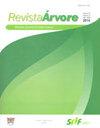巴西南部种植的四种桉树的基本木材密度、纤维尺寸和木材化学成分
IF 0.8
4区 农林科学
Q4 FORESTRY
引用次数: 1
摘要
在巴西的人工林部门,大多数使用的物种都来自桉树属。尽管巴西南部的气候适合松属的物种生长,但抗冻桉树的种植每年都在增加。摘要本研究的目的是评价benthamii桉树、dunnii桉树、saligna桉树和cloeziana桉树的基本密度、纤维尺寸和化学成分。所使用的树木来自圣卡塔琳娜州卡诺尼亚斯一个有六年历史的实验种植园。每个树种选择3棵树,分别在商品茎高的0%、25%、50%、75%和100%处取瓣。为了评价木材的质量,通过比较树种之间和茎高之间的值来确定木材的基本密度、纤维尺寸和化学成分。木的基本密度最高;该种纤维的长度和宽度也最大。dunnii的木质素含量最低,而全纤维素含量最高。木素含量最高的是benthamii木、saligna木和cloeziana木。木材性能与茎高之间的关系不相关。结果表明,在海拔越高的地方,总纤维素和木质素的含量越高(100%),且在所有海拔高度上,总纤维素和木质素的含量相似。本文章由计算机程序翻译,如有差异,请以英文原文为准。
BASIC WOOD DENSITY, FIBER DIMENSIONS, AND WOOD CHEMICAL COMPOSITION OF FOUR Eucalyptus SPECIES PLANTED IN SOUTHERN BRAZIL
ABSTRACT In the Brazilian planted forest sector, most of the species used are from the genus Eucalyptus. Even though Southern Brazil has a suitable climate for species of the genus Pinus, the planting of frost-resistant Eucalyptus species has been increasing annually. The objective of this study was to evaluate the basic density, fiber dimensions, and chemical composition of Eucalyptus benthamii, Eucalyptus dunnii, Eucalyptus saligna, and Eucalyptus cloeziana woods. The trees used were from a six-year-old experimental plantation located in Canoinhas, state of Santa Catarina. For each species, three trees were selected, and discs were removed from each tree at 0%, 25%, 50%, 75%, and 100% of the commercial stem height. To evaluate the quality of the wood, the basic wood density, fiber dimensions, and chemical composition of the wood were determined by comparing the values between species and between the heights in the stem. The highest basic density was that of the wood of E. cloeziana; this species also had the greatest length and width of fibers. E. dunnii had the lowest levels of lignin and the highest levels of holocellulose. The highest lignin content was found in the wood of E. benthamii, E. saligna, and E. cloeziana. The relationship between wood properties and stem height was not relevant. The results highlight the tendency for higher extractives to be found at taller heights (100%), and holocellulose and lignin content are similar at all heights.
求助全文
通过发布文献求助,成功后即可免费获取论文全文。
去求助
来源期刊

Revista Arvore
FORESTRY-
CiteScore
1.00
自引率
0.00%
发文量
32
审稿时长
4-8 weeks
期刊介绍:
A Revista Árvore é um veículo de comunicação científica da Sociedade de Investigações Florestais – SIF. O jornal é de acesso gratuito, revisado por pares, que publica bimestralmente trabalhos científicos originais no campo da Ciência Florestal. As áreas temáticas para publicação são: Ambiência e Conservação da Natureza, Manejo Florestal, Silvicultura e Tecnologia da Madeira e Utilização de Produtos Florestais.
A política editorial visa manter alta conduta ética em relação à publicação e aos seus funcionários, rigor na qualidade dos artigos científicos, seleção de revisores qualificados, respeito profissional aos autores e processo de tomada de decisão imparcial. A Revista Árvore publica artigos apenas em inglês.
Artigos de revisão podem ser publicados se houver uma discussão relevante resumindo o estado da arte sobre o assunto. A revisão estrita da literatura não é aceita.
 求助内容:
求助内容: 应助结果提醒方式:
应助结果提醒方式:


